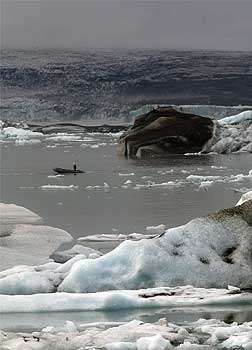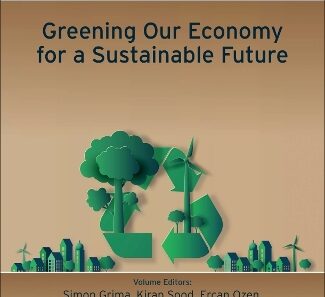The phenomenon of melting ice has emerged as one of the most disconcerting manifestations of climate change. This ice loss not only signifies environmental degradation but also acts as a catalyst for accelerating global warming. As glaciers retreat and polar ice caps diminish, the implications stretch beyond mere changes in landscape; they reverberate throughout the planet’s climate systems. Understanding the dynamics of ice loss and its multifaceted effects on global temperatures is essential for grasping the urgency of climate action.
At the crux of this issue is the concept of albedo. Albedo refers to the reflectivity of a surface; darker surfaces absorb more sunlight, while lighter surfaces reflect it. Ice and snow possess a high albedo, thus effectively reflecting solar radiation back into space. However, as ice melts, it exposes darker ocean waters or land, which absorb a greater amount of heat. This feedback loop leads to further warming and additional ice loss. The Earth’s average temperature incrementally rises, contributing to an unsettling trend that casts the future into uncertainty.
The polar regions stand as the frontline victims of climate change; they are warming at an alarming rate, nearly two to three times faster than the global average. The Arctic ice cap is shrinking both in extent and thickness, while Greenland’s ice sheet experiences unprecedented rates of melting. This is not merely a localized issue; the repercussions of Arctic melting resonate globally. Disruption to thermohaline circulation—commonly referred to as the ocean conveyor belt—could precipitate shifts in weather patterns worldwide, resulting in wild fluctuations in climate and greater frequency of extreme weather events.
One of the most critical impacts of melting ice is the elevated sea levels that ensue. It is estimated that the melting of Greenland and Antarctic ice sheets could raise global sea levels by several meters over the coming decades. This rise threatens coastal communities, infrastructure, and ecosystems, leading to displacement and loss of biodiversity. As saltwater encroaches into freshwater habitats, the ramifications for agriculture and drinking water supplies become dire. Urban areas with significant populations situated at or near sea level face existential risks, necessitating immediate adaptive measures and long-term planning.
Moreover, the melting of permafrost—a layer of permanently frozen ground—introduces additional atmospheric challenges. Permafrost contains trapped greenhouse gases, including methane and carbon dioxide. As it thaws, these gases are released, further amplifying the greenhouse effect. This presents a dual challenge: not only does ice loss contribute to climate warming, but thawing permafrost exacerbates it. The implications of this feedback loop are profound, as scientists warn that the release of these gases could accelerate climate change beyond current projections.
In addition to physical transformations, the melting of ice represents a profound ecological shift. Biodiversity in polar regions is at stake, as species dependent on ice-covered habitats face extinction. The iconic polar bear, seals, and various migratory birds are just a few examples of wildlife grappling with diminishing habitats. As these species struggle to adapt to rapidly changing environments, entire ecosystems risk collapse. The melting ice also influences nutrient cycles and food web dynamics, as shifts in phytoplankton populations at the base of the marine ecosystem can have cascading effects throughout the food chain.
Furthermore, the implications of melting ice are felt beyond the polar regions, affecting temperate and tropical climates. Ocean currents, altered by melting ice, play a vital role in regulating temperature and precipitation patterns across the globe. The disruptions to these currents can lead to droughts in some regions while instigating floods in others. The unpredictability of such changes poses a significant challenge to agricultural systems, water resources, and human livelihoods, particularly in vulnerable communities that lack resilience to climate variability.
The socio-economic ramifications of ice loss are considerable. As sea levels rise, millions of people may be displaced, leading to climate refugees and potential geopolitical conflicts over dwindling resources. Developing nations, often the least responsible for climate change, bear the brunt of its impacts, exacerbating existing inequalities. Global efforts to mitigate climate change, such as the Paris Agreement, become increasingly urgent as the clock ticks down on failing to address the ongoing loss of ice on Earth.
In response to these multifaceted challenges, innovative solutions are being explored. Enhancing the resilience of coastal infrastructure, investing in renewable energy sources, and advancing conservation efforts are paramount. Furthermore, climate mitigation strategies must emphasize the necessity of reducing greenhouse gas emissions to counteract the effects of climate change. Public awareness and engagement are crucial; advocacy for sustainable practices and the implementation of policies aimed at reducing ecological footprints can contribute to meaningful change.
The narrative surrounding melting ice is not solely one of despair. It is a clarion call to action, compelling individuals, communities, and governments to confront the realities of climate change head-on. The loss of ice is both a dire warning and an opportunity for transformative change. Armed with knowledge and resolution, humanity has the power to address the crisis, ensuring a stable climate for future generations. The melting worlds challenge us to rethink our relationship with the planet, fostering a mindset of stewardship and sustainability in an era marked by unprecedented change.






